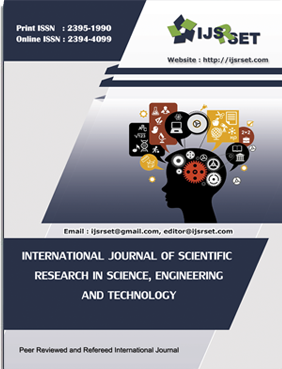Revolutionizing Plant Disease Detection: A Review of Deep Learning and Machine Learning Algorithms
DOI:
https://doi.org/10.32628/IJSRSET2411227Keywords:
Convolutional Neural Network, Plat Disease Detection, Image RecognitionAbstract
The food industry has led the agricultural economy of the state all India to prosperity. India has historically been the largest producing nation having identity of Agricultural Land. Grains , fruits , Vegetables , such as potatoes, oranges, Tomato ,sugarcane and other specially grains and cottons are the chief crops of the India. Citrus and cotton industries have been a driving force behind Maharashtra's impressive economic growth.. The situation has created job opportunities for many people, boosting the state's economic potential. To maintain the prosperity of citrus and cotton industries, Government has been concerned about disease control, labour cost, and global market.
During the recent past, citrus canker and citrus greening, Black spot-n cotton has become serious threats to citrus in Maharashtra. Infection by these diseases weakens trees, leading to decline, mortality, lower yields, and decreased commercial value. Likewise, the farmers are concerned about costs from tree loss, scouting, and chemicals used in an attempt to control the disease. An automated detection system may help in prevention and, thus reduce the serious loss to the industries, farmers and Economy of country.
This research aims to the development of disease detection with pattern recognition approaches for these diseases in crop. The detection approach consists of three major sub-systems, namely, image acquisition, image processing and pattern recognition. The imaging processing sub-system includes image preprocessing for background noise removal, leaf boundary detection and image feature extraction. Pattern recognition approaches will be use to classify samples among several different conditions on crops.
In order to evaluate the classification approaches, results will be compared between classification methods for the different induvial fruits, vegetable, grains disease detection. Obtained results will help in demonstration of classification accuracy which is targeted as better than existing for proposed model as high as 97.00%. This study aimed to assess the potential of identifying plant diseases by examining visible signs on fruits and leaves. These data collection and initial knowledge acquisition is plan in offline approaches. By implementing this simple model, we can achieve a more favourable cost-to-production ratio compared to complex solutions.
📊 Article Downloads
References
Y. Xu, S. Kong, Z. Gao, Q. Chen, Y. Jiao, and C. Li, ‘‘HLNet model and application in crop leaf diseases identification,’’ Sustainability, vol. 14, no. 14, p. 8915, Jul. 2022. DOI: https://doi.org/10.3390/su14148915
A. Pandey and K. Jain, ‘‘A robust deep attention dense convolutional neural network for plant leaf disease identification and classification from smartphone captured real world images,’’ Ecol. Informat., vol. 70, Sep. 2022. DOI: https://doi.org/10.1016/j.ecoinf.2022.101725
A. G. Aitken and I. J. Warrington. (2020). Fresh Facts. Plant & Food Research. [Online]. Available: https://www.freshfacts.co.nz/files/freshfacts-2020.pdf
J. Liu and X. Wang, ‘‘Plant diseases and pests detection based on deep learning: A review,’’ Plant Methods, vol. 17, no. 1, pp. 1–18, Dec. 2021. DOI: https://doi.org/10.1186/s13007-021-00722-9
M. H. Saleem, J. Potgieter, and K. M. Arif, ‘‘Automation in agriculture by machine and deep learning techniques: A review of recent developments,’’Precis. Agricult., vol. 22, no. 6, pp. 2053–2091, 2021. DOI: https://doi.org/10.1007/s11119-021-09806-x
V. S. Dhaka, S. V. Meena, G. Rani, D. Sinwar, K. Kavita, M. F. Ijaz, and M. Woźniak, ‘‘A survey of deep convolutional neural networks applied for prediction of plant leaf diseases,’’ Sensors, vol. 21, no. 14, p. 4749, Jul. 2021. DOI: https://doi.org/10.3390/s21144749
Kim SK, Pallela R. Medicinal foods from marine animals: current status and prospects. Adv Food Nutr Res 2012. DOI: https://doi.org/10.1016/B978-0-12-416003-3.00001-9
Zoysa MD. Nutritional value, bioactive compounds, and health-promoting properties of abalone. Marine Nutraceuticals: Prospects and Perspectives, 2013.
Koizumi Y, Tsuji Y. Abalone Haliotis spp. In: Application of Recirculating Aquaculture Systems in Japan. Tokyo: Springer; 2017. DOI: https://doi.org/10.1007/978-4-431-56585-7_8
Kobayashi T, Kijima A. Effects of inbreeding depression in Pacific abalone Haliotis discus hannai. J Shellfish Res 2010. DOI: https://doi.org/10.2983/035.029.0313
Downloads
Published
Issue
Section
License
Copyright (c) 2024 International Journal of Scientific Research in Science, Engineering and Technology

This work is licensed under a Creative Commons Attribution 4.0 International License.




